by Winding Pathways | Dec 24, 2020 | (Sub)Urban Homesteading, Chickens, Garden/Yard
Late December is special. There are lots to be thankful for and a good reason to celebrate. The solstice just passed, promising a daily addition of sunlight and signaling that spring is on the way. Then there’s a multitude of seasonal, cultural holidays and Holy Days. St. Lucia’s Day, Las Posadas, Yule Winter Solstice, Boxing Day, Kwanzaa, Christmas, and New Year’s Day.
People everywhere enjoy special year-end treats. For us, it’s stollen and pickled herring plus delicious cookies and, in some years, a tender roast beef dinner.
We remember our chickens and give them special year-end treats. They need it. Few things are as delicious to a hen as a juicy grasshopper or fresh grass shoot. By now those are just memories, and the poor birds have to make do with a diet of nutritious, but boring, commercial mash.
Jazz Up the Diet and Relieve Boredom
So, while keeping plenty of quality mash in the feeder, we jazz up their diet with these things:
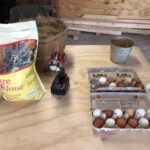
We vary the treats.
Mealworms: Our chickens might not like them as much as a June caterpillar but dried mealworms are a great winter substitute, so we sprinkle a couple of handfuls in the coop every day. These treats can be bought online or in farm and pet stores.
Sunflower seeds: Many people put sunflower seeds out for cardinals, chickadees, and other birds to enjoy on frosty days. Chickens also love them. We toss a handful of black oil sunflower seeds with the hulls on into the coop. They quickly disappear.
Squash seeds: We enjoy eating butternut and other winter squash during the cold days. Our chickens devour the seeds.
Scratch: Chickens love eating commercial scratch grain, a blend of corn, milo, wheat, and oats. A handful or two a day is plenty. It’s chicken candy but low in protein. Be careful when buying scratch. Some brands include a high percentage of milo, a grain that chickens don’t favor. It’s a round reddish colored seed. Try buying scratch with a low milo content.
Flock block: Each winter we buy a flock block. They’re made by several companies and are compressed scratch grain fortified with molasses and other treats. We simply put the heavy block on the coop floor. It takes the birds several weeks to eat it all and keeps them busy picking out tidbits. Farm and pet stores sell them. Some folks make their own!
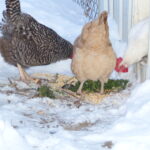
We toss a few treats outside the pophole door to entire the hens outside in winter.
On winter days, before enjoying our morning coffee and breakfast we open our coop’s pop hole door and scatter some chicken treats. We’re sure to say good morning and thanks to our hard-working hens.
-
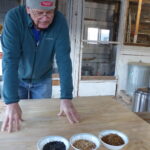
-
Rich shows three treats while a hen in the coop checks out what is happening.
-
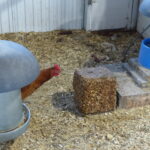
-
Hens check out new foods carefully.
-
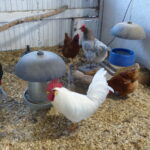
-
Chickens gather ’round the Flock Block.
-
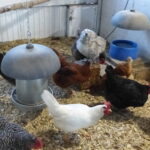
-
Satisfied that the Flock Block is something good, the hens and rooster begin to peck at it.
by Winding Pathways | Sep 10, 2020 | (Sub)Urban Homesteading, Chickens, Garden/Yard
Clouds darkened in the late morning of August 10, 2020, as a thunderstorm warning was broadcast by radio stations. That’s common during Iowa summers, so we weren’t overly concerned. A half-hour later, a roaring wind engulfed Cedar Rapids. It was a derecho bearing winds up to 140 miles an hour.
We watched our young trees bend before the tempest. Then came the terrible part.
First, our black oaks tumbled down. Then, the black cherries and hackberries tumbled down before the wind. Our massive black walnut stood until a ferocious blast tore its branches and leaves off.
The derecho lasted longer than most – over 40 minutes – and left as quickly as it had arrived. The damage was mindboggling. We soon learned that Cedar Rapids lost 65% of its trees. A quick count showed that 47 of our 53 mature trees were either on the ground or stripped of leaves and branches. We lost privacy and shade and gained a view.
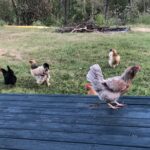
For several days the chickens were truly “free-ranging.”
We worried about our 20 chickens. The storm came so quickly that we couldn’t lure them into the coop. The wind destroyed the chicken run’s fence. The birds were fine and, with the fence down, began their first neighborhood tour. Even before the rain stopped!
We couldn’t erect a temporary fence for several days, so the chickens were truly free-ranging. They roamed around, and we often didn’t even know where they were.
But, every once in a while, a hen returned to the coop to lay her egg in the nest.
Each sundown all the chicks came home for the night. All 20!
With power off and vast damage over a large area, we were fearful about food. Our freezer warmed and the wind damaged many of our garden crops. Would grocery stores reopen????. Could we even get through on the tree chocked roads??? We didn’t know. But it was soon obvious that our hens were nonplussed by the storm and kept giving us fresh eggs.
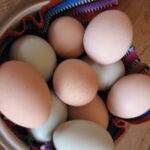
The chickens kept on laying eggs.
Assuming a chicken flock survives an immediate disaster – flood, fire, or storm – they’ll continue laying nutritious eggs when other food may not be available. They are valuable disaster companions.
by Winding Pathways | Nov 14, 2019 | (Sub)Urban Homesteading, Chickens
Mealworms in the Snow Mama and Chicks in the Snow
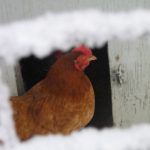
Hens are not dumb clucks!
We were surprised to look out the window on Veteran’s Day morning to see nearly six inches of snow outside. The predicted snow skiff turned into a dump, and we soon fired up the snowblower and put the shovels to use. This much snow in early November is unusual.
Just before we started shoveling, our chickens demonstrated their amazing ability to learn and remember. Every morning we open the pop hole door, and the hens zoom outside with enthusiasm to discover tasty bugs and weed seeds to eat. When we opened the door after the snow, our older hens peered out the door, turned around, and decided the cracked corn we scattered inside the coop was a fine breakfast. They’d remembered snow from last year and knew walking in it yielded cold toes and legs.
Most of our hens are newbies, hatched in mid-July. They’d never seen snow, and when we opened the pop hole door they roared outside, stood perplexed, walked around for a few minutes, and then came right back inside. And, the rooster sang his call from inside. No doubt their toes were cold.
Chickens are often considered witless animals lacking even a shred of intelligence. We know otherwise. Remembering snow proved that our old hens had learned what it was last winter and remembered their cold toe experience over the eight long months since the last frozen white stuff melted. Chickens are no dumb clucks.
by Winding Pathways | Apr 5, 2018 | (Sub)Urban Homesteading, Chickens, Garden/Yard
It may seem odd for a bird that evolved in tropical Southeast Asia to thrive up in the frigid north but increasing numbers of people are enjoying the benefits of backyard chickens in Canada, Maine, Michigan’s Upper Peninsula, in Northern Minnesota, and even Alaska.
Although, chickens are hardy and adaptable, raising them way up north requires special management. Among the challenges both chickens and their owners face is frigid temperatures, vastly different day lengths between winter and summer, and the sometimes difficulty of buying feed and supplies in areas far from where chicken culture is common.
Steve Brown, extension agent for the University of Alaska Fairbanks Cooperative Extension office, Palmer, AK, has been advocating chicken husbandry in Alaska for many years. He has a flock and regularly helps others acquire and manage birds. It’s challenging but the rewards are many.
Frigid Temperatures
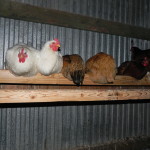
Chickens sheltered from the cold.
Everyone knows Alaska is a cold place, so during the long winter hens need a coop that protects them from the wind and predators and moderates the temperature some. Moisture causes chicken manure in litter to quickly generate ammonia so keeping the coop dry is important. Brown uses the deep litter method to keep the coop floor dry and only occasionally warms his coop when temperatures drop really low.
Daylight
Chickens are daytime creatures and in southern Alaska there’s upwards of 17 hours of darkness in the winter. “LED bulbs solve the lighting problem and keep expenses down. Electricity is expensive here, and LED bulbs provide great light while consuming little energy, keeping my costs down,” said Brown. During warm seasons he lets his chickens forage in the yard and also uses a chicken tractor.
Supplies
Nearly all food is shipped to the state, so finding fresh eggs is challenging, but Steve and many others enjoy eggs that come directly from the coop. Fresh eggs sell for $8 a dozen!

Chicks can successfully be shipped to the cold north.
But, where do the chicks come from? “I buy chicks from a company in Texas. They airmail them to me and they arrive in good shape. Usually I buy about 100 chicks, raise them for several weeks and sell most of them to other families who want chickens using Alaskas List, like Craig’s List. I keep a small flock at my home,” he said.
Feed and supplies are hard to come by in Alaska and expensive. “I don’t buy grit but collect sand and small pebbles from a nearby river bank, and I feed my chickens a lot of kitchen scraps, dog food, and fish scraps. Sometimes fishy taste gets into the eggs,” he said.
Brown sticks with hardy brown egg laying breeds which stand the cold better than Leghorns. “I like Chanteclers, Rhode Island Reds, Plymouth Rocks, and Orpingtons,” he said.
Continental Climate Chickens
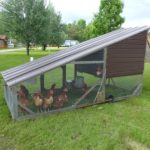
Chicken Tractor
Another family that raises far north chickens is Paul and Karen Colson. They probably raise the most northern flock in the contiguous United States. They live in Minnesota’s Northwest Angle. The Angle is a relatively small area bounded by the Lake of the Woods and Manitoba. To reach it, a driver must enter Canada, drive NE about 40 miles, and then reenter this remote part of the United States. Like Alaska, nearly all supplies must be hauled in a long distance.
The Colsons raise broilers and keep a small flock of laying hens. Although not as far north as Alaska they face the same challenges of cold, day length, access to supplies, and predators as Brown does and manage their chickens in a similar way.
No place is really too far north to keep chickens. It takes more time and work to keep hens healthy in a harsh climate but the fresh eggs and meat they provide make it worthwhile.
by Winding Pathways | Jun 15, 2017 | Chickens, Hoover's Hatchery
If you missed our first Facebook Live watch this Hoover’s Hatchery video.
We chatted about Chickens and Gardens, Insects and Pests, Keeping Chickens cool in the summer and free from insect bites and predator invasions, and gave some tips on keeping water and feeders “poop” free.
We’re live with Winding Pathways talking with Hoover’s Hatchery about gardening with chickens!
Posted by Hoover’s Hatchery on Thursday, June 15, 2017
Join us next time.












